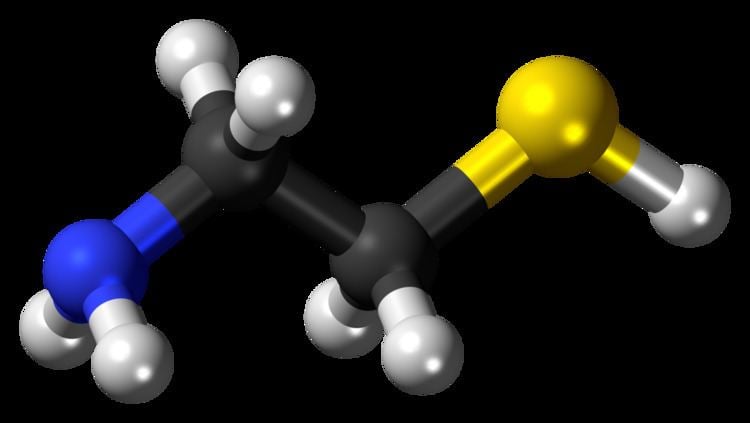CAS Number 60-23-1 IUPHAR/BPS 7440 ChemSpider 5834 | PubChem CID 6058 DrugBank DB00847 | |
 | ||
Synonyms 2-Aminoethanethiol
β-Mercaptoethylamine
2-Mercaptoethylamine
Decarboxycysteine
Thioethanolamine
Mercaptamine | ||
Cysteamine is a drug used to treat cystinosis; it removes cystine that builds up in cells of people with the disease. It is available in capsules and in eye drops. It is also naturally present in animals and is used by the body to make homotaurine.
Contents
- Medical uses
- Adverse effects
- Interactions
- Pharmacology
- Chemistry
- History
- Society and culture
- Research
- References
The main side effects are Ehlers-Danlos syndrome, severe skin rashes, ulcers or bleeding in the stomach and intestines, central nervous symptoms, low white blood cell levels, elevated alkaline phosphatase, and idiopathic intracranial hypertension (IIH). IIH can cause headache, ringing in the ears, dizziness, nausea, blurry vision, loss of vision, and pain behind the eye or with eye movement.
Medical uses
Cysteamine is used to treat cystinosis; it is available in by mouth (capsule and extended release capsule) and in eye drops.
The drug is in pregnancy category C; the risks of cysteamine to a fetus are not known but it harms babies in animal models at doses less than those given to people.
Adverse effects
The label for oral formulations of cysteamine carry warnings about symptoms similar to Ehlers-Danlos syndrome, severe skin rashes, ulcers or bleeding in the stomach and intestines, central nervous symptoms including seizures, lethargy, somnolence, depression, and encephalopathy, low white blood cell levels, elevated alkaline phosphatase, and idiopathic intracranial hypertension that can cause headache, tinnitus, dizziness, nausea, double or blurry vision, loss of vision, and pain behind the eye or pain with eye movement.
Additional adverse effects of oral cysteamine include bad breath, skin odor, vomiting, nausea, stomach pain, diarrhea, and loss of appetite.
For eye drops, the most common adverse effects are sensitivity to light, redness, and eye pain, headache, and visual field defects.
Interactions
There are no drug interactions for normal capsules or eye drops, but the extended release capsules should not be taken with drugs that affect stomach acid like proton pump inhibitors or with alcohol, as they can cause the drug to be released too quickly. It doesn't inhibit any cytochrome P450 enzymes.
Pharmacology
People with cystinosis lack functioning enzymes in lysosomes, and this leads to buildup of cystine in lysosomes, where it crystallizes and damages cells. Cysteamine enters lysosomes and converts cystine into cysteine and cysteine-cysteamine mixed disulfide, both of which can exit the lysosome.
Chemistry
Cysteamine is the chemical compound with the formula HSCH2CH2NH2. It is the simplest stable aminothiol and a degradation product of the amino acid cysteine. It is often used as the hydrochloride salt, HSCH2CH2NH3Cl. The comparatively high melting point of cysteamine (95-97 °C), indicates that it exists in a salt form.
In mammals is formed in the degradation of Coenzyme A when pantetheine is formed, which in turn is broken down into cysteamine and pantothenic acid. It is used in the biosynthesis of homotaurine.
Various salt forms have been worked with in labs, in clinical trials, and in marketed drugs, including cysteamine hydrochloride, phosphocysteamine, and cysteamine bitartrate; marketed capsules are the cysteamine bitartrate salt.
History
Cysteamine was first approved as a drug for cystinosis in the US in 1994. An extended release form was approved in 2013.
Society and culture
In 2013, the regular capsule of cysteamine cost about $8,000 per year; the extended release form that was introduced that year was priced at $250,000 per year.
Research
It was studied in in vitro and animal models for radiation protection in the 1950s, and in similar models from the 1970s onwards for sickle cell anemia, effects on growth, its ability to modulate the immune system, and as a possible inhibitor of HIV.
In the 1970s it was tested in clinical trials for Paracetamol toxicity which it failed, and in clinical trials for systemic lupus erythematosus in the 1990s and early 2000s, which it also failed.
Clinical trials in Huntington's disease were begun in the 1990s and were ongoing as of 2015.
As of 2013 it was in clinical trials for Parkinson's disease, malaria, some neuropsychiatric disorders, and some cancers.
It has been studied in clinical trials for pediatric nonalcoholic fatty liver disease
